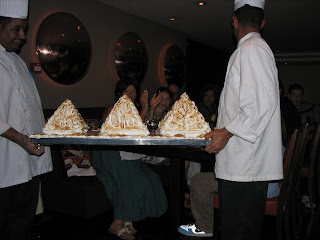First off, we dragged ourselves out of bed to watch the sunrise during the boat's last stretch on the river before it docked at Luxor.


Then it was off to Karnak. A thousand years after the pyramids were built, Karnak was just a small temple dedicated to the local god, Amun. With the beginning of the 18th dynasty (around 1570 BC), this site became a religious center for the country with each pharoah adding his or her (in the case of Hatshepsut) elaborate homage to Amun. These also served as a tribute to the pharoahs' posterity as well, of course. :) Here's the entrance to Karnak...notice the row of sphinxes on the left:

The photos one always sees from Karnak is the great Hypostyle hall, built by Seti I and completed by his very famous son, Ramses II and I must admit that I couldn't stop taking photos of it. Amelia Edwards, an Englishwoman who traveled through Egypt in the 1870s, describes it perfectly in her memoir "A Thousand Miles up the Nile":
How often has it been written, and how often must it be repeated, that the Great Hall at Karnak is the noblest architectural work ever designed and executed by human hands? One writer tells us that it covers four times the area occupied by the Cathedral of Nôtre Dame in Paris. Another measures it against St. Peter's. All admit their inability to describe it ; yet all attempt the description. To convey a concrete image of the place to one who has not seen it, is, however, as I have already said, impossible. If it could be likened to this place or that, the task would not be so difficult ; but there is, in truth, no building in the wide world to compare with it. The Pyramids are more stupendous. The Colosseum covers more ground. The Parthenon is more beautiful. Yet in nobility of conception, in vastness of detail, in majesty of the highest order, the Hall of Pillars exceeds them every one. This doorway, these columns, are the wonder of the world. How was that lintel-stone raised? How were these capitals lifted? Entering among those mighty pillars, says a recent observer, "you feel that you have shrunk to the dimensions and feebleness of a fly." But I think you feel more than that. You are stupefied by the thought of the mighty men who made them. You say to yourself :--"There were indeed giants in those days."





David, Sara, and Steve letting all that history settle a bit before heading to the next site.
Next was the Luxor temple. A sphinx-lined road once connected Karnak to the Luxor temple, a mile away. A major project has been launched to unbury and restore this road to its former glory. I'm standing on the beginning of this road with Luxor temple behind me:

You can see the statues of Ramses II flanking the entrance. Ramses II was the one who erected the two obelisks as well. As you can see, only one is left, as one was given by Mohammad Ali in the 1800s to King Louis-Philippe in France who erected in the Place de la Concorde. King Louis-Philippe graciously sent a clock to Mohammad Ali, the first electric clock in the Middle East, as a thank you....except it didn't work. It stands today in the Citadel in Cairo....you may remember the whole story from our entry last September here . Doesn't the obelisk look lonely??
In the afternoon, we visited Hatshepsut's mortuary temple, Deir el Bahri. She built this for the purpose of housing her funerary cult as well as a way of strengthening her claim that she was the physical daughter of the god Amun and therefore was fit to be King. Reliefs throughout the temple show Amun claiming her as his offspring as well as other scenes from her twenty-year rule. We were struck by how Greek the temple looked.

No photos from the Valley of the Kings as we were only allowed into three tombs and we weren't allowed to take photos...actually cameras were forbidden on the premises. During the late Kingdom period, pharoahs were realizing that if the goal was to secure their mummy for the afterlife, publicizing their ornate burial chambers filled with treasure with a huge pyramid probably wasn't the best route. They started building their tombs in a valley miles away from Thebes, underground and unmarked. As we know today, this also didn't work, as all the royal tombs were robbed....all except for that of a certain famous pharoah whose name was King Tutankhamun. As I said, I went into three tombs: Seti I, Ramses III, and Ramses V. The colors and scenes painted in the underground chambers were dazzling!
Back at the boat, we ended our night with a wonderful gala dinner. The dessert was Baked Alaska in the form of the Giza pyramids, presented to each table as the rest of the staff played lively music, and then lit on fire....Fabulous!!

Part of the entertainment at the end of the night was a whirling dhervish, who twirls constantly to music for hours. Our whirling dhervish only twirled for about 20 minutes which was enough for me but I liked this photo:

2 comments:
GREAT pictures + comments!!
There is a theory suggesting that the Deir El-Bahri temple, in the Early Christian Period, was used as a Coptic monastery.
Post a Comment